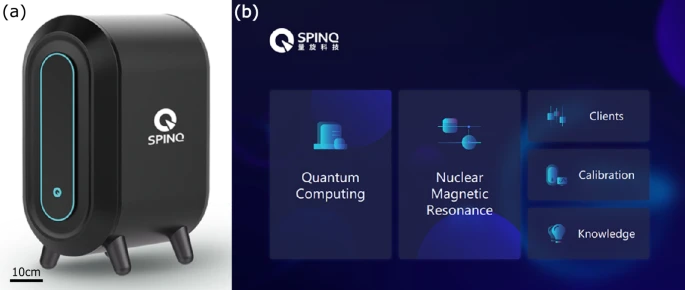SpinQ Technology is a Chinese start-up company based in Shenzhen, China. SpinQ focuses on quantum computing and aims to lead the world into a new quantum science era. It hopes to do this by promoting the industrialization and popularization of Quantum computing.
SpinQ recently exposed its intentions to sell a desktop quantum computer created for $5,000. The SpinQ desktop is not the company’s first attempt at quantum computer creation and has initially sold one of its first quantum desktop computers (SpinQ Gemini) for $50,000. The Gemini device was hefty and weighed 55kg (121bs), hence the emergence of a new design. SpinQ says that its new machine is more sizable, weighs lesser, and is more affordable than its predecessor.
The Nuclear Magnetic Resonance Technique
The SpinQ machine, in contrast to extensive quantum computers, can process only 2 qubits and uses nuclear magnetic resonance. In the nuclear magnetic resonance process, specially selected molecules are trapped inside a magnetic field and zapped with radio frequency pulses to manipulate the spins of the atoms contained in it.
After the radio pulse zaps, the relaxed atoms emit radio frequency signals and exhibit their new state. In this new state, the spin of atoms can be interchanged (0 into 1) and make the spins of atoms nearby interact. This interaction can induce mathematical operations and further record results.
The SpinQ machine uses Dimethyphosphite as its central compound molecule. It consists of one hydrogen atom, one phosphorus atom, one oxygen, and two CH3O groups (Tetrahedral molecule). The tetrahedral’s phosphorus and hydrogen atoms bond closely enough to interact and be manipulated separately, making it the perfect compound.
At room temperature, the dimethylphosphite is liquid and colourless. By placing a small drop of liquid in a container in the middle of the magnetic field, a vast number of molecules are used to make sure the radio signals from the atoms are strong enough to read. This process was used long ago in building the first quantum computers.
Although this process was expensive because of the powerful superconducting magnet required, SpinQ bypassed this by using permanent magnets that can produce huge electromagnetic fields and further employed a technique called “shimming” to eliminate irregularities in the field. Therefore, achieving a highly regular and strong magnetic field.
Even as this device processes only two qubits, it can perform huge calculations that would be difficult with a classical computer. However, with the basis of nuclear magnetic resonance, the computer cannot handle more than a dozen qubits, and it is clear that it might never stand up to quantum computers used by Google and Microsoft.
While some may argue that the SpinQ device should not be called a quantum computer, SpinQ Technology insists that the main aim of the device is to demonstrate and educate students by self trial.
Features of the SpinQ Gemini Quantum Computer
The SpinQ computer consists of the following distinct features:
SpinQuasar: This part compromises five modules which are:
- The instrument calibration allows users to calibrate the spectroscopy parameters such as temperature and field shimming.
- The NMR spectroscopy which gives access to the nuclear magnetic resonance signal.
- The quantum computing module which is the device’s interface.
- The task management and dynamic library module which supports cloud computing and APIs respectively.
Masterboard: It houses the FPGA, analog-digital converter, ADC, digital-analog converter DAC and other digital parts. These parts release the algorithm that generates RF pulse and measures readout signals.
Magnets: Permanent magnets are used to generate a homogeneous magnetic field for splitting the nuclei and forming a qubit.
RF Pulse Generation System: The RF Pulse Generation System is designed to maintain the quantum state since the Lamor frequency of the nuclei is within the RF pulse range.
Field Shimming: It reduces the homogeneity of the magnetic field from ~20 ppm which is too high to less than ~1ppm.
Temperature Control: The magnetic field operates at room temperature. The temperature control ensures the temperature of the permanent magnet doesn’t exceed room temperature.
Dimethylphosphite Molecules: 31P and 1H nuclear spins in Dimethylphosphite connected directly forms the two-qubit processor found in the SpinQ computer.
SpinQ technology believes that this device will prove useful for educational purposes in colleges, high schools and homes. Hence, the price and portability. This is in line with their announcement in January 2021 where the R&D team of SpinQ said “We expect that the price of quantum computers can be reduced”. It appears the SpinQ technology has actualized its vision of manufacturing relatively affordable quantum computers.

